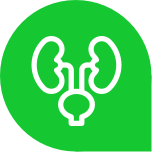isitfabry.sg
Symptoms
What are the signs and symptoms of Fabry disease?
The signs and symptoms of Fabry disease affect a diverse range of organs4 and may include:

Circulatory System/Heart
Left ventricular hypertrophy (enlarged heart), arrhythmia (irregular heartbeat), ischaemia (reduced blood supply to tissues)4

Kidneys
Progressive renal failure, cysts, albuminuria/proteinuria (protein in urine)4

Eyes
Cornea verticillate (fine, whorl-like superficial corneal opacities)1

Hearing
Hearing impairment, vertigo, tinnitus (ringing in ears)4

Digestive System
Abdominal pain, nausea, vomiting, constipation, diarrhoea4

Brain
Stroke, transient ischaemic attack (ministroke), neuropsychiatric problems4

Skin
Angiokeratomas (small raised dark red spots appear on the skin)4

Nervous system
Acroparesthesia (pain/burning sensation/numbness in hands and feet), hypohidrosis (little or no sweating), temperature sensitivity4
Fabry disease is associated with a wide range of symptoms1.
Signs and symptoms of Fabry disease have been reported to begin at an early age, with a mean age of symptom onset of approximately 6 and 9 years in boys and girls, respectively2,3.
Early symptoms often appear in childhood, and can include chronic neuropathic pain, gastrointestinal dysfunction such as abdominal pain and diarrhoea, hypohidrosis (or little to no sweating), heat and cold intolerance, and fatigue3,5.
Disease progression leads to a variety of systemic manifestations, including renal disease, cardiomyopathy and stroke; and are often accompanied by depression4,5,6.
The progressive nature of Fabry disease means symptoms may become more frequent and severe with age7.







